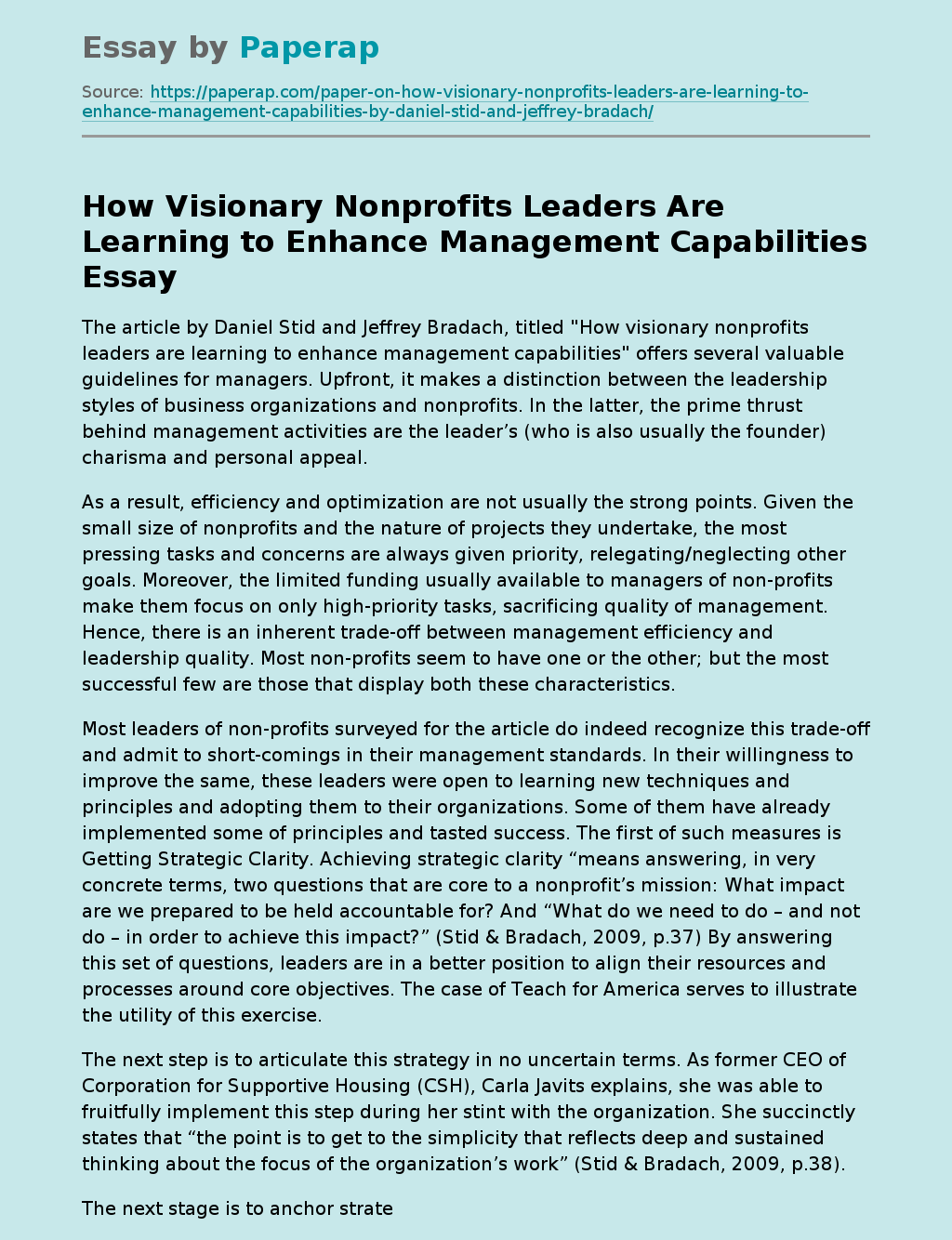How Visionary Nonprofits Leaders Are Learning to Enhance Management Capabilities
The article by Daniel Stid and Jeffrey Bradach, titled “How visionary nonprofits leaders are learning to enhance management capabilities” offers several valuable guidelines for managers. Upfront, it makes a distinction between the leadership styles of business organizations and nonprofits. In the latter, the prime thrust behind management activities are the leader’s (who is also usually the founder) charisma and personal appeal.
As a result, efficiency and optimization are not usually the strong points. Given the small size of nonprofits and the nature of projects they undertake, the most pressing tasks and concerns are always given priority, relegating/neglecting other goals.
Moreover, the limited funding usually available to managers of non-profits make them focus on only high-priority tasks, sacrificing quality of management. Hence, there is an inherent trade-off between management efficiency and leadership quality. Most non-profits seem to have one or the other; but the most successful few are those that display both these characteristics.
Most leaders of non-profits surveyed for the article do indeed recognize this trade-off and admit to short-comings in their management standards.
In their willingness to improve the same, these leaders were open to learning new techniques and principles and adopting them to their organizations. Some of them have already implemented some of principles and tasted success. The first of such measures is Getting Strategic Clarity. Achieving strategic clarity “means answering, in very concrete terms, two questions that are core to a nonprofit’s mission: What impact are we prepared to be held accountable for? And “What do we need to do – and not do – in order to achieve this impact?” (Stid & Bradach, 2009, p.
37) By answering this set of questions, leaders are in a better position to align their resources and processes around core objectives. The case of Teach for America serves to illustrate the utility of this exercise.
The next step is to articulate this strategy in no uncertain terms. As former CEO of Corporation for Supportive Housing (CSH), Carla Javits explains, she was able to fruitfully implement this step during her stint with the organization. She succinctly states that “the point is to get to the simplicity that reflects deep and sustained thinking about the focus of the organization’s work” (Stid & Bradach, 2009, p.38).
The next stage is to anchor strategic clarity with a few important performance metrics. Homing in “on a small number of key metrics can be a powerful way to keep everyone in the organization focused on both the fidelity of the implementation and the ultimate outcomes” (Stid & Bradach, 2009, p.38). The non-profit Jumpstart had practically implemented this step and tasted success, as testified by its CEO Rob Wladron.
Then, the way to creating strong management practices is by ‘Building and Aligning the Team’. This is done through several means. Identifying and appointing right personnel for secondary management positions so that they possess requisite experience and skills are important. Equally important is for them to have a mindset oriented around existing systems and processes. The real case of non-profit Communities for Schools (CIS) illustrates and underscores the significance of this step in consolidating management practices.
And finally, helping the organization see the benefits of efficient management goes a long way in sustaining those improvements. If the employees/volunteers see these steps for improvement as distractions or cumbersome or unnecessary, then there will be no progress. Hence it is essential for leaders to help people see the upside of more rigorous management practices, “not only because the pain and disruption of new ways of working always precede the benefits, but also because personal commitment to the organization’s mission is what tends to keep the best people on board” (Stid & Bradach, 2009, p.39).
In conclusion, by systematically dissecting chronic issues confronting non-profit organizations, the author duo of Daniel Stid and Jeffrey Bradach have done an admirable job of offering solution to it. By laying out a list of steps to be taken by leaders, Stid and Bradach’s article serves as a useful reference for managers of nonprofits everywhere. The authors neatly illustrate how successful nonprofits in America such as Teach For America (TIA), Jumpstart, Communities in Schools, Corporation for Supportive Housing (CSH), etc have practically implemented some of these steps and how they benefited as a result. These examples make their suggestions quite persuasive and credible.
In my opinion, I don’t think Rawlings’ operations in Costa Rica are exploitative. The very nature of capitalist enterprise is such that cost efficiency is a major driver of business. To criticize Rawlings for doing what it is legally mandated to do (namely, to seek profits for is shareholders) is quite unfair. Moreover, critics are not appreciating how Rawlings has created jobs in the Costa Rican economy. Companies such as Rawlings have helped consolidate Costa Rican economy. It is in recognition of this fact that the Costa Rican government has offered special economic zone status to Rawlings and other MNC manufacturing units.
Even when one looks at wages and employee benefits, Rawlings has done nothing illegal. The company has adhered to minimum wage standards of Costa Rica. Further it complies by paid-leave and medical insurance .
How Visionary Nonprofits Leaders Are Learning to Enhance Management Capabilities. (2019, Dec 05). Retrieved from https://paperap.com/paper-on-how-visionary-nonprofits-leaders-are-learning-to-enhance-management-capabilities-by-daniel-stid-and-jeffrey-bradach/

